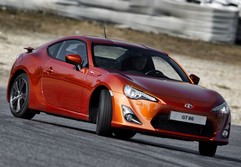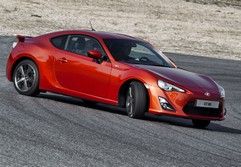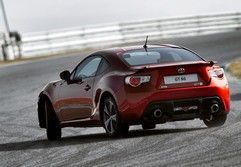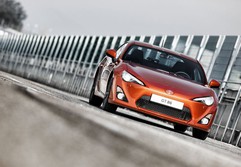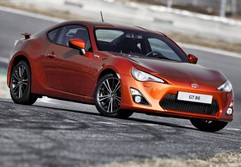Driven: Toyota GT86
We finally get to sample Toyota's eagerly-awaited coupe in Europe (but only on a track...)
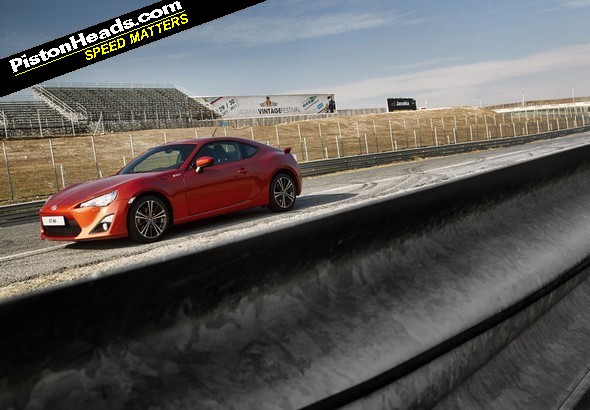
It's at this point that I have to admit to compromising my own strict standards by accepting such an invitation. Normally a 24hr trip to Madrid with no more than 20 minutes guaranteed seat-time on a flat circuit would be declined, because it wouldn't tell any of us enough about the car in question to be worthwhile. But I've been dying to have a go in one of these since seeing the FT 86 concept up close in Brussels two years ago, so principles can go hang.
First, the technical bit
I'm assuming we all know enough about the concept of this car, and its origins to move straight into the driving bit? No? OK, for those of you who have been visiting another galaxy for the past few years, this is the Toyota FT 86, close brother to the almost-identical Subaru BRZ. It will have other names in other parts of the world, but for Europe it is GT86, paying direct homage to the 1980s AE 86, the Mk2 Escort of Japanese performance cars.
This car is significant for several reasons - size, price, performance, driven wheels, and several others - but one surely stands above all others. It is this: when you ask Tada-san, the engineering boss in charge of the project the usual, turgid, Nurburgring lap-time question, he just shrugs and smiles. He doesn't care: "This doesn't matter."
Has a man ever been more correct about a subject than Tada-san about ordinary road cars at the Nurburgring? In the scheme of a mass-market, rear-driven coupe which panders to the lusts of people like us, it seems like a frivolous observation, but to me it is a powerful metaphor for the direction in which this new product takes fun motoring: the GT86 is about driving and the driver; not about numbers and performance.
Numbers? The GT86 certainly doesn't smite you with its awesomeness, but who cares about 200hp when the most important figure lurks further down the info sheet: a kerb weight of 1210kg. If Toyota brings a poverty-spec version to the UK, as is expected by many people. This is a genuinely light vehicle.
So how does it feel?
It feels just that as you climb into that wide, single door and your backside hangs in the air a fraction longer than you expected before hitting the seat squab. The reason? You sit low with legs jutting forward onto the pedal box and the gear lever just where you want to rest your right palm. The steering wheel adjusts up-down-in-out and, at first, feels like it doesn't want to come close enough to your chest, but that's a momentary problem. This is the best sub-£30K driving position. If ever a driving tone, a dynamic intention was set by the relationship between pedals, seat and stumpy gear-lever, this is it.
Ahead of you is a large, centrally mounted rev-counter with a red section beginning in the mid-7s; inset within the circle is a digital speed readout. It is among the clearest instrumentation available on any street car, but it isn't self-consciously ornamental - it just does a job. This is a theme that pervades the entire cabin, not that I can be bothered to look just now and waste another minute of driving time.
Are they sure it's a flat-four? There's not much thrum and rumble. Blip the throttle and expect a little Ari Vatanen-in-a-Legacy baaaaaaaarp and you'll be disappointed, but then ever since Subaru equaled the length of the intakes on these Boxer motors something has been lost from the soundtrack.
Straight or sideways?
Throttle response is keen, the gearshift during those first tentative moments down the pitlane makes you smile: short, but not too resistant. You drive the car smoothly, not because you are any good, but because the car flatters your inputs.
Personal and professional discipline dictates that I should leave the traction control on for a while to tell you what it's like. I can tell you that it works well for the first three of Jarama's technical turns and that, despite being bone dry, it has work to do in such conditions. The sport button brings another level of slip-allowance, which seems like it might be worth investigating for a while longer. Time to think about the steering. Light-ish, but just about right in terms of speed. A flat racing circuit isn't a great place to judge the feel of something like this, but I liked it, and thought the wheel was well judged for size and shape.
It's in the faster turns that the GT86's chassis balance brings the first big grins. Here is a production car that offers nothing more than a semblance of the safety-understeer that blights many modern performance cars. Turn in and the nose pushes just a fraction wide, but it really is a tiny shift because you then feel the weight move back through the bodyshell - that the car wants to steer itself from the rear axle. Not in some gratuitous drift, but that you - the driver - have as much control over the positioning of the car with your right foot as with the steering wheel.
This hasn't existed in an affordable coupe for many, many years. I'm almost tearful. Exaggeration, but it's a wonderful discovery.
Sport mode is eradicated by pressing, and holding, the large 'OFF' button next to it. Only now does the full effect of 200hp, 1210kg and Prius tyres come to life. Even moderate-radius second-gear turns need sizeable steering corrections and before long the GT 86 is pulling slides of a duration you wouldn't think possible looking at its vital statistics.
The clever thing is it remains both fast and grippy when you want it to be, but can lapse into this childishness at the push of a button and a twist of its Torsen locking differential. It is also quite softly sprung, rolling gently and giving the driver ample feedback. I like that.
Have we missed anything out?
What else did we learn from our short time with the car? That it needs to work above 5,000rpm to give its best - no surprises there - but that close gear ratios make it easy to sustain. That the sound is a disappointment, that the standard brakes didn't like the abuse and began to fade after three laps, that the cabin is all it needs to be and not much more and that the 'ickle rear seats look pretty uninviting. That the front seats are very good. And that anyone who likes driving should try one of these the moment they land in the UK this summer.
As you can probably tell, I like this car. Toyota says it wants to shift 4,000 units in an average year, meaning a few more might trickle through in 2012/2013. The owners are in for a treat.
TOYOTA GT86
Engine: 2.0-litre flat-4
Power (hp): 200
Torque (lb ft): 151
0-62mph: 7.0 sec*
Top speed: 143mph*
Weight: 1,200kg*
MPG: 42mpg* (NEDC combined)
CO2: 160g/km*
Price: c. £25,000
*All figures provisional
Gassing Station | General Gassing | Top of Page | What's New | My Stuff

